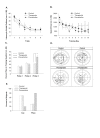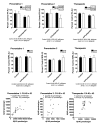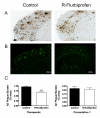Chronic administration of R-flurbiprofen attenuates learning impairments in transgenic amyloid precursor protein mice
- PMID: 17650315
- PMCID: PMC1948891
- DOI: 10.1186/1471-2202-8-54
Chronic administration of R-flurbiprofen attenuates learning impairments in transgenic amyloid precursor protein mice
Abstract
Background: Long-term use of non-steroidal anti-inflammatory drugs (NSAIDs) is associated with a reduced incidence of Alzheimer's disease (AD). We and others have shown that certain NSAIDs reduce secretion of Abeta42 in cell culture and animal models, and that the effect of NSAIDs on Abeta42 is independent of the inhibition of cyclooxygenase by these compounds. Since Abeta42 is hypothesized to be the initiating pathologic molecule in AD, the ability of these compounds to lower Abeta42 selectively may be associated with their protective effect. We have previously identified R-flurbiprofen (tarenflurbil) as a selective Abeta42 lowering agent with greatly reduced cyclooxygenase activity that shows promise for testing this hypothesis. In this study we report the effect of chronic R-flurbiprofen treatment on cognition and Abeta loads in Tg2576 APP mice.
Results: A four-month preventative treatment regimen with R-flurbiprofen (10 mg/kg/day) was administered to young Tg2576 mice prior to robust plaque or Abeta pathology. This treatment regimen improved spatial learning as assessed by the Morris water maze, indicated by an increased spatial bias during the third probe trial and an increased utilization of a place strategy to solve the water maze. These results are consistent with an improvement in hippocampal- and medial temporal lobe-dependent memory function. A modest, though not statistically significant, reduction in formic acid-soluble levels of Abeta was also observed. To determine if R-flurbiprofen could reverse cognitive deficits in Tg2576 mice where plaque pathology was already robust, a two-week therapeutic treatment was given to older Tg2576 mice with the same dose of R-flurbiprofen. This approach resulted in a significant decrease in Abeta plaque burden but no significant improvement in spatial learning.
Conclusion: We have found that chronic administration of R-flurbiprofen is able to attenuate spatial learning deficits if given prior to plaque deposition in Tg2576 mice. Given its ability to selectively target Abeta42 production and improve cognitive impairments in transgenic APP mice, as well as promising data from a phase 2 human clinical trial, future studies are needed to investigate the utility of R-flurbiprofen as an AD therapeutic and its possible mechanisms of action.
Figures



Similar articles
-
In vitro and in vivo profiling of CHF5022 and CHF5074 Two beta-amyloid1-42 lowering agents.Pharmacol Res. 2007 Apr;55(4):318-28. doi: 10.1016/j.phrs.2006.12.010. Epub 2007 Jan 16. Pharmacol Res. 2007. PMID: 17292621
-
CHF5074, a novel gamma-secretase modulator, attenuates brain beta-amyloid pathology and learning deficit in a mouse model of Alzheimer's disease.Br J Pharmacol. 2009 Mar;156(6):982-93. doi: 10.1111/j.1476-5381.2008.00097.x. Br J Pharmacol. 2009. PMID: 19239474 Free PMC article.
-
Multi-target action of the novel anti-Alzheimer compound CHF5074: in vivo study of long term treatment in Tg2576 mice.BMC Neurosci. 2013 Apr 5;14:44. doi: 10.1186/1471-2202-14-44. BMC Neurosci. 2013. PMID: 23560952 Free PMC article.
-
M1 muscarinic agonists can modulate some of the hallmarks in Alzheimer's disease: implications in future therapy.J Mol Neurosci. 2003;20(3):349-56. doi: 10.1385/JMN:20:3:349. J Mol Neurosci. 2003. PMID: 14501019 Review.
-
Mechanisms of action of non-steroidal anti-inflammatory drugs for the prevention of Alzheimer's disease.CNS Neurol Disord Drug Targets. 2010 Apr;9(2):140-8. doi: 10.2174/187152710791011991. CNS Neurol Disord Drug Targets. 2010. PMID: 20205646 Free PMC article. Review.
Cited by
-
4'-O-methylhonokiol increases levels of 2-arachidonoyl glycerol in mouse brain via selective inhibition of its COX-2-mediated oxygenation.J Neuroinflammation. 2015 May 13;12:89. doi: 10.1186/s12974-015-0307-7. J Neuroinflammation. 2015. PMID: 25962384 Free PMC article.
-
Protein aggregation diseases: pathogenicity and therapeutic perspectives.Nat Rev Drug Discov. 2010 Mar;9(3):237-48. doi: 10.1038/nrd3050. Nat Rev Drug Discov. 2010. PMID: 20190788 Review.
-
R-flurbiprofen attenuates experimental autoimmune encephalomyelitis in mice.EMBO Mol Med. 2014 Nov;6(11):1398-422. doi: 10.15252/emmm.201404168. EMBO Mol Med. 2014. PMID: 25269445 Free PMC article.
-
Amyloid precursor protein transgenic mouse models and Alzheimer's disease: understanding the paradigms, limitations, and contributions.Alzheimers Dement. 2009 Jul;5(4):340-7. doi: 10.1016/j.jalz.2009.03.002. Alzheimers Dement. 2009. PMID: 19560104 Free PMC article. Review.
-
Non-steroidal anti-inflammatory drugs and cognitive function: are prostaglandins at the heart of cognitive impairment in dementia and delirium?J Neuroimmune Pharmacol. 2012 Mar;7(1):60-73. doi: 10.1007/s11481-011-9312-5. Epub 2011 Sep 20. J Neuroimmune Pharmacol. 2012. PMID: 21932048 Free PMC article. Review.
References
-
- Golde TE, Eckman CB, Younkin SG. Biochemical detection of Abeta isoforms: implications for pathogenesis, diagnosis, and treatment of Alzheimer's disease. Biochim Biophys Acta. 2000;1502:172–187. - PubMed
Publication types
MeSH terms
Substances
Grants and funding
LinkOut - more resources
Full Text Sources
Other Literature Sources
Medical

